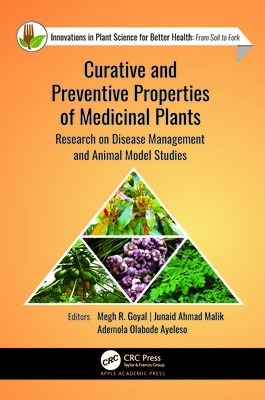
- We will send in 10–14 business days.
- Publisher: Apple Academic Press
- ISBN-10: 1774911957
- ISBN-13: 9781774911952
- Format: 15.6 x 23.4 x 2.4 cm, hardcover
- Language: English
- SAVE -10% with code: EXTRA
Curative and Preventive Properties of Medicinal Plants (e-book) (used book) | bookbook.eu
Reviews
Description
Animal models varying from mammals to flies and worms are widely used in studying human diseases. These models share homolog genes as expressed in human disease conditions, helping to elucidate mechanisms and pathways of these diseases in different organs of the animals, which might be difficult to assess in clinical-based research. This book provides scientific reports on therapeutic potentials of medicinal plants in different animal models and provides information on the beneficial roles of the medicinal plants on human diseases.
The chapters look at number of different medicinal plants in conjunction with several different animal models, examining the medicinal properties and activities of the plants for a variety of health issues, such as for diabetes, cardiovascular disease, neurodegenerative disease, organ dysfunctions, cancer, for labor and postpartum issues, and more. The therapeutic mechanism of some phytoconstituents is also discussed.
This important compendium provides valuable information for researchers and scientists involved in drug delivery and development, pharmacognosy, pharmacology, and biochemistry.
EXTRA 10 % discount with code: EXTRA
The promotion ends in 19d.15:52:26
The discount code is valid when purchasing from 10 €. Discounts do not stack.
- Publisher: Apple Academic Press
- ISBN-10: 1774911957
- ISBN-13: 9781774911952
- Format: 15.6 x 23.4 x 2.4 cm, hardcover
- Language: English English
Animal models varying from mammals to flies and worms are widely used in studying human diseases. These models share homolog genes as expressed in human disease conditions, helping to elucidate mechanisms and pathways of these diseases in different organs of the animals, which might be difficult to assess in clinical-based research. This book provides scientific reports on therapeutic potentials of medicinal plants in different animal models and provides information on the beneficial roles of the medicinal plants on human diseases.
The chapters look at number of different medicinal plants in conjunction with several different animal models, examining the medicinal properties and activities of the plants for a variety of health issues, such as for diabetes, cardiovascular disease, neurodegenerative disease, organ dysfunctions, cancer, for labor and postpartum issues, and more. The therapeutic mechanism of some phytoconstituents is also discussed.
This important compendium provides valuable information for researchers and scientists involved in drug delivery and development, pharmacognosy, pharmacology, and biochemistry.


Reviews